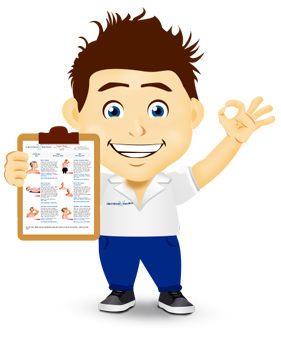
Next steps:
Feel free to read the advice sheet below! To get the full benefit click on 'Start treatment'. By starting the treatment you will get access to weekly rehab programmes online for FREE. You will be able to track your progress, pain levels and we will remind you to do your exercises every day!
Tennis elbow (known as lateral epicondylitis) is a painful condition within the elbow caused from overusing the joint. Playing tennis and other racquet sports can cause this condition to occur, but there are other activities and sports that can place you at risk. Tennis elbow is when the tendons joining the forearm muscles along the outside part of the elbow become inflamed. The forearm tendons and muscles become damaged from overusing the joint. Repeatedly performing the same muscles over and over cause injuries to the joints, which leads to tenderness and pain on the outer part of the elbow.
Tennis Elbow Anatomy
The elbow joint is made up of three bones: the upper arm bone (humerus) and the two bones within the forearm (ulna and radius). Bony bumps at the bottom part of the humerus are referred to as the epicondyles. The bony bump along the outside part of the elbow is known as the lateral epicondyle. Ligaments, muscles and tendons all hold the joint together.
Tennis elbow involves injury to the tendons and the muscles in the forearm. The forearm muscles work to extend the fingers and the wrist. The forearm tendons attach the bone and the muscles together. They are attached on the lateral epicondyle. The tendon that is often involved with this condition is the extensor carpi radialis brevis.
How to Treat Tennis Elbow:
- Stop aggravating your arm pain
This might sound obvious, but identify the movement that is causing the pain. It is usually a repetitive movement such as mouse clicking, carrying shopping, gripping an object or playing a certain sport. When you identify the causative factor, reduce or stop the movement. - Rest
The first step in the recovery process is to allow your arm the time needed to rest. Stop participating in sports or any heavy work activities for at least a few weeks.
- Ice and/or Heat
Contrast bathing is an excellent way to reduce inflammation. You can do this by applying ice to the outside of your elbow, followed by heat. You can use either or both. Make sure you wrap the ice and/or heat in a towel to prevent any burns.

- Check Your Equipment
If you are participating in any racquet sports, you might need to have your equipment checked to make sure it fits properly. Racquets that are stiffer or looser-strung can reduce the amount of stress placed on the forearm, which means they won’t have to work as hard. If you are using an oversized racquet, change to a smaller head and see if that helps.
- Use a Coach
Seek advice from a coach on correct technique for your sport, as poor technique can put your arm and elbow in a mechanically poor position, leaving it at risk of tennis elbow. - Physical Therapy
Specific exercises are beneficial for strengthening the muscles within the forearm. The therapist can also perform an ultrasound, muscle-stimulating techniques and massage to improve healing in the muscle.

- Acupuncture
Seeing a therapist who performs acupuncture directly to the outside of the elbow can help to reduce pain and inflammation.
- Tennis Elbow Support
A tennis elbow support fits below the elbow, and creates what is known as a “false origin” in that it makes your arm think that the tendons are joining further down your arm. This helps to reduce the symptoms by allowing the tendons and the muscles to rest.
- Check your Computer Posture
Ask a colleague to take a photo of your side profile at work, take that picture in to see your therapist, and they will guide you on good computer set-up.

Tips:
- Many people with this condition participate in some type of activity that requires vigorous or repetitive use of the muscles in the forearm.
- Plumbers, painters and carpenters are prone to developing this condition.
- Cooks, auto workers and butchers get this condition more often than the rest of the population.
- Improper equipment and technique increase your chance of developing the condition when playing tennis or other racquet sports.
- The condition can also occur without any known recognized repetitive injury.

